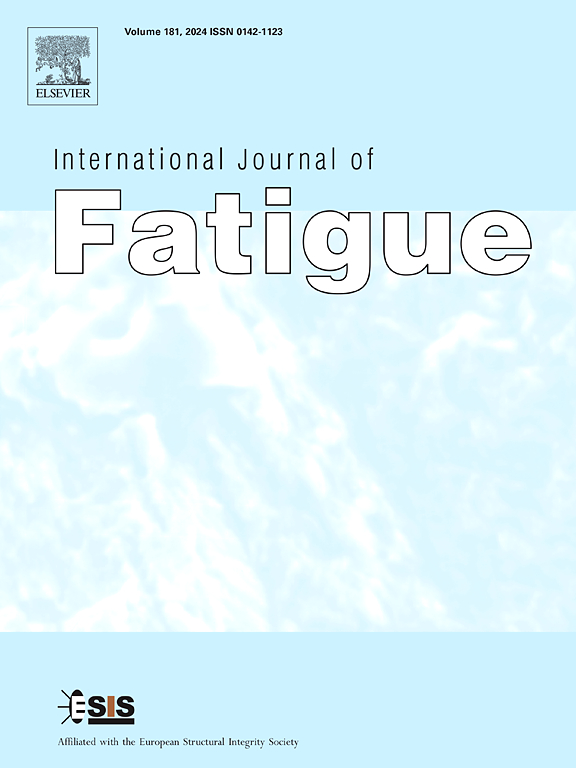基于多微磁无损检测融合法的中碳钢疲劳损伤早期检测与监测
IF 5.7
2区 材料科学
Q1 ENGINEERING, MECHANICAL
引用次数: 0
摘要
基于45个碳钢缺口试件的应力控制疲劳试验,采用微磁无损检测技术对试件的疲劳损伤演化过程进行了现场综合评价,并确定了描述试件实际疲劳状态的各种磁参数。总的来说,从磁滞、巴克豪森噪声和增量磁导率测量中提取的特征量在疲劳早期表现出初始振荡的趋势,反映了疲劳软化。随着负载周期的增加,磁性参数趋于稳定,并在失效前的最后阶段发生剧烈变化。显然,疲劳磁化行为的动态依赖关系与循环加载损伤的渐进累积有关。其中磁增量磁导率法对宏观裂纹产生前的疲劳损伤具有较高的敏感性。其中,增量磁导率信号的均值特征值近似从疲劳寿命的80%开始呈非线性增量,可用于定量评估损伤程度。此外,在94.2%的寿命下,平均值具有独特的过零特征,可作为构件即将发生疲劳失效的预警。本文章由计算机程序翻译,如有差异,请以英文原文为准。
Early detection and monitoring of fatigue damage in medium carbon steel based on multi-micromagnetic NDT fusion method
Based on stress-controlled fatigue tests of 45 carbon steel notched specimens, an in-situ comprehensive evaluation of fatigue damage evolution was accomplished via micromagnetic non-destructive testing techniques, and various magnetic parameters were then determined to describe the actual fatigue state. In general, the characteristics quantities extracted from magnetic hysteresis, Barkhausen noise and incremental permeability measurements exhibited a trend of initial oscillations during the early stages of fatigue, reflecting fatigue softening. As the load cycle increased, the magnetic parameters became stabilized and experienced drastic changes in the final stage before failure. Evidently, the dynamic dependence of fatigue magnetization behavior was related to the progressive accumulation of damage by the cyclic loading. Among those, the magnetic incremental permeability method was highly sensitive to the fatigue damage before a macroscopic crack was initiated. Particularly, the Mean eigenvalues of incremental permeability signals presented a nonlinear increment behavior, starting approximately from the 80 % of fatigue life, which could be used to assess the degree of damage quantitatively. Furthermore, the unique zero-crossing feature of Mean value at 94.2 % lifetime can serve as a warning for imminent fatigue failure of the component.
求助全文
通过发布文献求助,成功后即可免费获取论文全文。
去求助
来源期刊

International Journal of Fatigue
工程技术-材料科学:综合
CiteScore
10.70
自引率
21.70%
发文量
619
审稿时长
58 days
期刊介绍:
Typical subjects discussed in International Journal of Fatigue address:
Novel fatigue testing and characterization methods (new kinds of fatigue tests, critical evaluation of existing methods, in situ measurement of fatigue degradation, non-contact field measurements)
Multiaxial fatigue and complex loading effects of materials and structures, exploring state-of-the-art concepts in degradation under cyclic loading
Fatigue in the very high cycle regime, including failure mode transitions from surface to subsurface, effects of surface treatment, processing, and loading conditions
Modeling (including degradation processes and related driving forces, multiscale/multi-resolution methods, computational hierarchical and concurrent methods for coupled component and material responses, novel methods for notch root analysis, fracture mechanics, damage mechanics, crack growth kinetics, life prediction and durability, and prediction of stochastic fatigue behavior reflecting microstructure and service conditions)
Models for early stages of fatigue crack formation and growth that explicitly consider microstructure and relevant materials science aspects
Understanding the influence or manufacturing and processing route on fatigue degradation, and embedding this understanding in more predictive schemes for mitigation and design against fatigue
Prognosis and damage state awareness (including sensors, monitoring, methodology, interactive control, accelerated methods, data interpretation)
Applications of technologies associated with fatigue and their implications for structural integrity and reliability. This includes issues related to design, operation and maintenance, i.e., life cycle engineering
Smart materials and structures that can sense and mitigate fatigue degradation
Fatigue of devices and structures at small scales, including effects of process route and surfaces/interfaces.
 求助内容:
求助内容: 应助结果提醒方式:
应助结果提醒方式:


